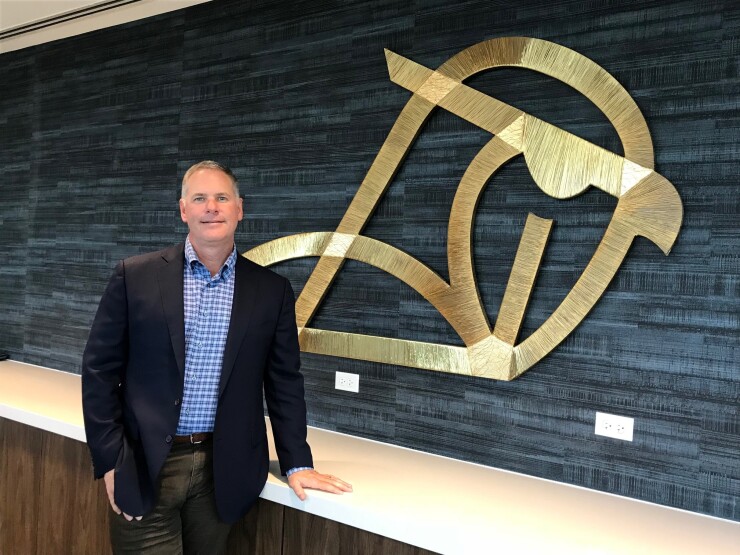The wealth management industry has a misunderstanding about private equity, according to Kestra Financial CEO James Poer.
“Private equity’s not evil. Private equity’s just an investor,” he said in an hour-long interview at the Stone Point Capital-backed independent broker-dealer’s headquarters in Austin, Texas. “It’s that simple.”
Poer bristles at suggestions that PE ownership acts as a downside for the 2,300 advisors at Kestra and subsidiaries Kestra Private Wealth Services and H. Beck. He also takes exception with the notion that the firm has not been active in acquisitions this year or that it should be recruiting new advisors en masse.

However, some of the firm’s rivals have been boosting their advisory ranks through recruiting and acquisitions. In one of its recent recruiting campaigns, LPL Financial called PE owners “inherently capricious” to try to woo advisors from Kestra and other PE-backed firms,
LPL has not had the same, if any, success in recruiting from Kestra as with PE-owned firms
PE companies are
The lack of IBD acquisitions this year for Kestra doesn’t surprise Henschen, who says the insurance-owned BDs changing hands have more low producers who wouldn’t fit Kestra’s model. Technology and good home-office service make the firm a frequent landing spot for advisors, he says.
“Of the different private equity models, I think they have the best service of any of them,” Henschen says, noting differences among PE acquirers. “It’s a mix. There are good stories and bad stories. And the current owners of Kestra, I like. They’ve been hands off, they’ve been supportive.”
-
The practice is at least the second this year to jump from the Advisor Group firm to its similarly sized rival.
September 20 -
The move marks the fifth new office added by the hybrid RIA this year.
June 11 -
Kestra Private Wealth Services CEO Rob Bartenstein says the new practice makes the fourth new office added this year by the hybrid RIA.
May 29
Firms of all sizes have helped push fee-based business above commissions as the industry undergoes a transformation.
Funds managed by Stone Point
Poer and other executives designed the office space with an eye toward advisor services, clustering vice presidents in the middle of operational teams equipped to handle their requests. The company tracks how quickly service calls from advisors are answered on a monitor displayed prominently in the office.
“We’re kicking ass today,” Poer said, gesturing toward the monitor. He later noted that 92% of calls are getting picked up by Kestra’s staff in 30 seconds or less, identifying quick service and updated versions of all their tech as a focus of the company’s efforts — rather than boosting advisor headcount.
Kestra’s recruiting pickups will add between $45 million and $50 million in production this year, according to Poer. In late October, Kestra also
Poer declines to say how much Kestra or its PE backer expects to spend on the purchase of Reliance Trust from global fintech firm FIS. The deal, which is slated to close by the end of the year, will allow Kestra advisors to offer personal trust services under their existing client relationships.
“Trust services are important now; they’re going to be even more important 10 years from now,” says Poer, noting

The company requires 20 to 60 hours of training for each employee every year, arranging for regular sessions punctuated by breakfast tacos in a small auditorium onsite. In addition to photos of Austin landmarks, Kestra has decorated the office with pictures of advisors, staff members and their families.
“They’re not a number at Kestra,” COO Kris Chester, who
Poer says Kestra is “very active” in looking at potential M&A pickups of other IBDs. The firm has decided not to go through with any of them in the past year or so because they didn’t present “the right fit for us.” It also currently also owns nine outside RIAs, he says.
Kestra, which

The capital is helping the firm grow, but Kestra’s competitors note that the PE spigot may dry up when it’s time for the firm to get return on its investment. For its part, LPL has not commented publicly on any details of its recruiting campaigns, and the company denies it targets specific firms for recruiting.
PE ownership certainly represents a hot topic among the largest IBDs, among firms like LPL which have
PE owners’ decisions are “dictated by their key performance indicator, which is the bottom line,” says Commonwealth Managing Principal John Rooney. “We’re willing to play the long game. We’re not looking to monetize our situation in three to five to seven years.”
Representatives for Stone Point didn’t respond to requests for comment. The PE firm has raised more than $19 billion in capital to invest in more than 100 companies in the past 25 years, according to its website, which lists at least seven other BDs or merchant trading firms in its current or past portfolio.
“Our business model is designed to team up with experienced management teams poised for even greater success, and Kestra is no exception,” Stone Point CEO Chuck Davis
Poer doesn’t “sit around worrying about competition,” he says, arguing there’s “a lot of opportunity for all of us.”
Some 20 years ago, he went on, Kestra probably would have gone public. Instead, Stone Point fills the void, serving as a “high-end M&A banking team on our behalf” without being involved in running the business, Poer says.
“A good private equity firm should want return on their investment,” he says. “That doesn’t really change anything for the advisors that are served. It’s capital structure, that’s it.”






